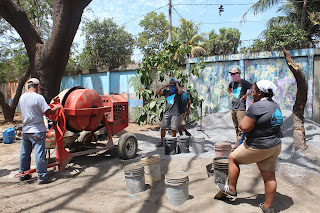Nathan C - Final Reflection on Social Aid
Prompt:
If you were to imagine yourself doing some social aid work what would it be? And in comparing these models (JHC and Ometepe) what would you intentionally model from them and why?
Reflection:
In the past two weeks I have been in Nicaragua, I have seen, experienced, and interacted with communities facing a wide range of issues stemming from Poverty. With limited access to food, water, medical attention, and even education, most people throughout Nicaragua, need help. One of many ways to help is social aid, which can take multiple forms. Social aid work is a very beneficial program for communities, as it provides communities with basic needs and can even work to ensure a communities positive future by addressing these needs. Two very different methods of social aid work currently being done in Nicaragua are exhibited by the Jubilee House Community, as well as Ometepe Bilingual School. In this reflection, I will decide on social aid work that I would do in a community, and compare and analyse JHC and OBS and incorporate principles used by both organizations, to make my own type of social aid work method.
Because of how influential and important poverty and education are to me, I would closely associated with these issues if I were to perform social aid work in any community. Poverty, and the inability for people to receive basic necessities, and education, the lack of people to be informed of how to work and improve their community, could be a really bad mix. Therefore, I would probably perform social aid work as a volunteer in an impoverished community.
Comparing JHC and OBS, there are several aspects of both methods that I would model after to make my social aid program. One of the biggest differences between JHC and OBS is that JHC asks the community for their prioritized necessities, whereas OBS, gives the community what the founder thinks is a necessity (Bilingual education). It is also important to realize that the OBS was built by a person in the community whereas JHC was made by people outside of the community. Looking at both instances, I think it is very important to involve people who interact, live, and are affected by the community they live in, because it ensures that decisions made directly impact the community in the most beneficial way. Another difference between JHC and OBS is that one has multiple projects, whereas the other, has only one focus. If I were to do social work in a community, I think it would be beneficial to have a very specific focus, that way all necessary resources can be allocated towards a specific problem in the community.
Through my first analysis and comparison of OBS and JHS, I have neglected to consider that the world around us is constantly evolving. In that regard, no matter how many issues an organization solves, a community may have even more the next day. It is an essential characteristic for any organization, especially that of social aid, to be reactive, just like JHC. After realizing that the community did not need a birthing center and instead requested better dental care, JHC repurposed its second building to a dental clinic during its construction. It is this reactiveness, that is essential for the well-being of a community and ensures that future challenges can be met.
There is also a big need to involve the outside world, and have programs dedicated to Outreach, with the goal of informing people of the situations that occur in the specific communities, and why they should be helped. For instance, the founder of the OBS informs tourists of the work being done at the school, which results in donations to the school over time. Informing the outside world of a peculiar community should be done to ensure that people around the world understand that these communities exist, and that they need help. Without JHC or OBS educating me, and our group, on these communities, I would have no idea the extent to which these communities suffered on a daily basis. In conclusion, education should be a big part of what the organization does on a daily basis.
Another big part of social aid programs is how they receive funding. I think it is extremely important for social aid programs to have some steady source of revenue that can be used to run parts of its mission. A steady source of revenue can be exhibited in the symbolic costs for healthcare at JHC, or the for-profit hotel that exists on the site of JHC. This means that the social aid program cannot just rely on donations from the outside world, but interact with the community and provide services which also benefits the community. Another way to receive money is to charge groups from around the world, for a tour guide, who would be able to teach them about the local community and points of interest.
Overall, social aid is a tremendously beneficial program if performed correctly. The above information regarding social aid skims the surface of what a program needs to do, and the list of details regarding a social aid program could go on and on. However, I think that for social aid, the above list can provide a solid foundation for any type of social aid in countries.
Thanks for Reading
Nathan

Comments
Post a Comment